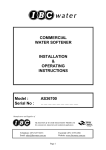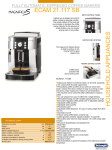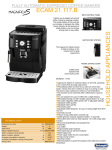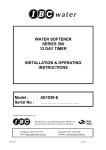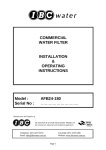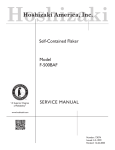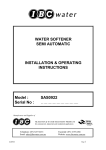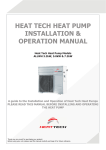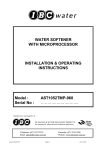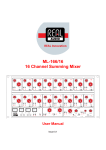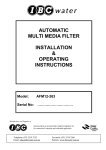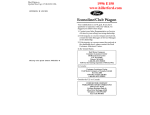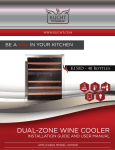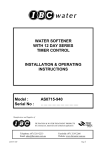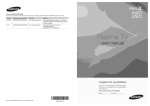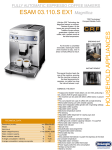Download AS20150-180 Serial No
Transcript
COMMERCIAL WATER SOFTENERS INSTALLATION & OPERATING INSTRUCTIONS Model : Serial No : AS20150-180 ……………………….. Manufacturer and FILTRATION & WATER TREATMENT PRODUCTS for commercial, industrial and residential application Telephone: (07) 3219 2233 Email: [email protected] AS20150-180 Facsimile: (07) 3219 2266 Website: www.ibcwater.com.au Page 1 INSTALLATION Check the equipment upon arrival for damage or shortages and report same to our Office or Agent before commencing installation. Locate the unit and brine tank on a firm level foundation, preferably concrete, with sufficient space for operation and maintenance. Level with shims if necessary, paying particular attention to the brine tank being placed on a flat clean surface. Position the tanks in their correct position before loading the Media. Make due allowance for space for maintenance purposes and for the brine tank salt replenishment. FIG.4 - INSTALLATION -- SINGLE TANK SOFTENER INSTALLATION * Pipework Layout - suggestive only Flow Controller supplied separate must be fitted before Connecting Drain Line * Unit Only supplied * Pipe, Valves, Solenoids, Water Meter supplied by others All pipework connections to be flanged or barrel union, for ease of removal and maintenance. * USE PIPEWORK SIZES SHOWN IN PERFORMANCE DATA TABLE 1 A B C D = = = = E = BRINE TANK Inlet Isolating Valve -- Manual Outlet Isolating Valve -- Manual Bypass Valve -- Manual - optional Water Meter - optional, fit only where metering of supply is required Solenoid Valve - optional, fit only where raw water to service is not required during REGENERATION. Valve must be 240V. 50Hz operation normally open and equal to pipeline size connect to terminals 2 and 5 inside valve cover (Refer Fig.12) BRINE TANK AS20150-180 BRINE TANK Page 2 MEDIA INSTALLATION Step 1: Remove the tank and riser tube assembly from the carton and make sure the softener tank is empty and clean. Step 2: Cover the riser pipe with a clean rag or plastic so that NO gravel or media enters the riser pipe, and hold the pipe down firm on the tank bottom. Step 3: Pour in the underbed gravel (No.6). Refer Table 1. 40kg. Step 4: Level out the underbed gravel using a broom handle/PVC pipe. The underbed gravel should cover the bottom screen of the riser pipe by about 25mm. CAUTION: Do not raise the riser pipe. If gravel is allowed to get under the distributor, empty and start again. Step 5: Load the resin. The resin is shipped in 25L bags. Refer Table 1. Step 6: Fill the tank with water to 50mm from the top. Step 7: Clean top of tank (neck & threads) of all traces of resin. Remove the rag or plastic fitted in Step 2, taking care not to raise the riser pipe. Step 8: Unpack the valve, remove the cap screws and separate the adaptor. Store gasket safely. Check that the tank ‘O’ ring seal is in place. Using a little silicone “O” ring lubricant, lubricate the inside surface of the Riser pipe ‘O’ Ring seal .. Refer Valve Assembly . NOTE: The softener will not produce soft water if the rubber Riser Pipe ‘O’ Ring is not in position correctly or is damaged. Step 9: Fit the adaptor to the tank, carefully, to allow the riser pipe to locate centrally. Screw down firmly by hand. Do not over tighten. Place the gasket on the tank adaptor, fit the valve body with cap screws provided. Tighten cap screws evenly. Refer valve assembly. Step 10: Screw the brine throttle gate valve assembly provided into the 180 Valve brine port located between the inlet and the outlet fittings. AS20150-180 Page 3 Step 11: Remove the brine valve from the brine well of the brine tank. Ensure brine tank is free from foreign matter and set brine valve as follows:Determine if wet salt or dry salt is required, using the formula shown in “Determining Frequency of Regeneration”. If sufficient information is not available to do the calculations shown in “Determining Frequency of Regeneration”, contact our office. The brine valve is supplied factory fitted with a dry salt riser, a wet salt riser is also supplied (short black screwed riser pipe ). Store the riser tube not used, DO NOT DISCARD it may be needed at commissioning. Adjust the brine valve float height based on the calculations. Step 12: Replace the brine valve in the brine well and connect brine tube - this tube is supplied long and can be cut to the desired length. Leave sufficient length to remove brine valve from brine well without disconnecting from the tube. Step 13: Now add the gravel (No.4) to the brine tank. Ensure no gravel enters brine well. Models AS20150 require 40kg. Refer Table 1. Step 14: Add salt to the tank (Refer Table 3 for correct quantity). Replace lid. Step 16: Plumb the unit, refer to Fig.4 & 5, noting the following:a) b) c) d) e) f) g) h) i) j) AS20150-180 Check arrow markings on the valve for correct inlet/outlet plumbing . Use only pipe size recommended in Table 2. Fit pipe unions or flanges to inlet, outlet, and drain line for ease of access for maintenance or cleaning. Install inlet and outlet isolating valves and a Manual Bypass Valve. Install optional solenoid and/or water meter if required. Ref. Fig 4&5. Connecting pipe work and valves MUST be supported to prevent loading on the valve and pipe work. Before connecting pipe work, flush all lines, close inlet, outlet and bypass valve. The drain line must discharge into an open pipe at least 80mm diameter no more than 7.5 metres from the unit. An air gap of 100mm should be allowed for inspection and to conform to sanitary codes. Power supply is required not more than 0.5 metres from the unit and should be a 3 pin 10amp 240v 50Hz GPO preferably earth leakage protected. Total power draw, 13 watts maximum. Fit external backwash flow controller using cap screws provided. Minimum operating pressure 205 kPa (30psi), maximum operating pressure 690 kPa (100psi). If supply pressure is above 690 kPa, fit pressure reducing valve. This must be a non-fluctuating supply. Water hammer and excess pressure will void factory warranty. Page 4 DETERMINING FREQUENCY OF REGENERATION After locating and installing the brine tank in the required position, it is necessary to know whether a wet or dry salt system is to be used. This is done by calculation as follows:NOTE: Less salt is required to regenerate a partially exhausted bed per gram of hardness removed, than that required for a more exhausted bed. For economy sake regenerate before full exhaustion. Calculate time between regenerations thus:C ----------- = N HxQ Where C = maximum capacity of unit as grams of CaCO3 (Refer Table 2) H = hardness of water a mg/l or ppm. Q = amount of water passed through the unit in kilolitres per day. N = maximum time between regenerations in days. The calculated value of N should be taken down to the nearest whole number. This is the maximum number of days which can be achieved between regenerations. The amount of salt needed per regeneration, is calculated thus:Total hardness removed (Exchange Capacity Required) = N x H x Q = A Where A = the total hardness removed as grams of CaCO3 The salt dosage for the exchange capacity required is found in Table 2. AS20150-180 Page 5 EXAMPLE: Softener AS16100 Litres of resin “150” from Table 1 Hardness of water 110 mg/l Flow 3.5kl/hr for 24 hours /day. Q H C = = = 3.5 x 24 =84 kl./day 110 mg/l or ppm 10500 grams Frequency of regeneration N = C HxQ = 10500 110 x 84 = 1.13 day Always go down to the nearest whole number (1 day). Exchange Capacity A = = = NxHxQ 1 x 110 x 84 9240 grams The minimum, medium and maximum capacities of a single unit from Table 2 are 5250, 7900 and 10500 respectively. The calculated capacity falls closer to the higher and so the higher value must be used. The Higher nearest Capacity must be used at all times. Salt dosage required for 10500 g is 36 kg (from Table 2). Now looking at Table 4 we find that both wet and dry salt can be used. However, if your calculated salt dosage allows you the choice of either dry or wet salt always choose dry salt. In the case of the example the salt dosage is 36 kg so the float setting is 350 mm (refer Brine Tank Set-up for float setting details), and the draw down rate should be adjusted to 17mm.per minute. Install the brine valve as shown in the illustration for Brine System setup. The initial salt load as shown in Table 3 should be loaded into the brine tank. IMPORTANT NOTE: The water softener, as supplied, has the brine riser pipe assembled to suit dry salt brine system. If, however, on reference to Table 4 you find that wet salt must be used, then wet salt brine rise pipe (short black pipe piece supplied) must be fitted to the brine valve. AS20150-180 Page 6 AS20150-180 Page 7 COMMISSIONING Step 1: Remove valve cover by partly unscrewing the three cover securing screws and lifting the cover forward. Remove the clear plastic window in the cover by removing two screws and loosening the other two screws and sliding the window out. Replace the cover on the valve. Connect the power lead to the power point and turn on the electric power. Depress the red knob (Fig. 7) and rotate anti-clockwise to backwash position, release red knob, Note that the timer face design can vary between valve models from that illustrated and that the regeneration positions are indicated pictorially with Backwash being Flow show in a Upward direction and the other regeneration positions shown with their corresponding flow path. Wait for valve drive to index to backwash position, (if not already in this position) that is the spindle is fully extended. Ensure that the brine throttle/stop valve is fully closed. Step 2: Just partly open inlet isolating valve. Allow unit to fill slowly (water will issue to drain) continue to run until the unit automatically indexes to brine rinse position which may take up to 15 minutes. This allows all the air to be removed. Step 3: Depress the red knob again and rotate anti-clockwise to the fast rinse position and release. Verify that the spindle has moved to it’s correct position as indicated in the following illustrations. Step 4: Open brine throttle/stop valve approximately 1.1/2 turns, fully open inlet isolating valve. Allow brine tank to fill until brine float valve shuts off. Generally it takes at least four hours to develop saturated brine, however new resin is in a fully regenerated state so it is only necessary to allow a half hour brine soak. Allow the red knob to return to the service position. It is recommended to give the softener a full regeneration so as to remove any colour throw and to further condition the resin. Depress the red knob and turn anti-clockwise to the start position or the first arrow position just anticlockwise from the service position then release the red knob, the unit will now go through each cycle Backwash, brine rinse, purge and back to service automatically, the full cycle will take approximately 90 minutes, depending on pin settings. NOTE: A small amount of media may pass to drain during the initial backwash, this is considered normal. When unit commences brine and rinse cycle, adjust brine throttle/stop valve to the correct draw down rate. Ref. Table 4. This draw down rate is checked by means of a tape measure from the top of the brine surface in the brine well and is the draw down rate in mm per minute. Step 5: Check with site supervisor that unit can go on line. If so - slowly open outlet isolating valve fully, check that manual bypass valve is fully closed. This unit is now on line. AS20150-180 Page 8 Step 6: Check for and report any leaks. Go to nearest tap, now on soft water, open and allow to flow for a few minutes. Using test kit to test for soft water - refer to Hardness Testing in back of these instructions. It may take several minutes for the soft water to pass to the tap. If hard water persists refer to the Trouble Shooting in these instructions. Check that the brine tank is full and that the float has shut off. Step 7: In the calculations you have done (determining regeneration frequency) you found the value for (N) - maximum time between regeneration in days. To set the skipper wheel up as required, pull all skipper wheel pins out. Turn the dial to the correct day of the week (note dials may be indicated as the actual day of week or as numbered days of the week) on which you are setting the dial. Now depress the pins for the desired day/s for regeneration/s required. If no data is available to do the calculations at this stage then set regeneration for every second day. Note: When you are setting the regeneration frequency you should take into account the working days, for instance if the installation will only work week days, regeneration on Friday and Monday would be a needless waste of salt. Always set in accordance with the duty conditions for maximum economy. NOTE: This is only a guide for initial setting and should be altered to suit each individual installation in accordance with load conditions - do the calculations in determining frequency of regeneration, it will help you in understanding the softener. Step 8: Set time of day, pull timer knob and set arrow to the time of day (time of your watch) note time of day may be as 12 hour or 24 hour clock, release, make sure that the knob has re-engaged gear, ie. knob right in. Step 9: After the softener has done the first regeneration and the regeneration sequence and time of day has been set, turn off the electric power and remove the valve cover ,then replace the clear plastic window in the cover and then replace the valve cover on to the valve and reconnect the electric power. This unit is now on line. Step 10: Do final check for leaks etc. Ensure instruction book is kept with relevant personnel. AS20150-180 Page 9 HARDNESS TEST 1. Water to be tested should be taken from a tap after the water softener 2. Measure 10ml of water into plastic bottle supplied (approximately 1/3 full) 3. Add one Yes/No tablet to sample water, replace cap and shake until tablet has completely dissolved. (NOTE: do not handle Yes/No tablet with fingers) 4. The final colour to be obtained for soft water is green. (Note: The shade of green may vary.) If the colour turns red, the water is above 20 mg/l hardness, therefore another regeneration is recommended. 5. Rinse plastic bottle after each test has been completed. 6. When used as above, the tablets change the colour from green to red at a hardness of approximately 20ppm based on a sample volume of 10mls. Other hardness test kits are available for more accurate testing eg. Hardness Tablets Directions: Take a 50ml sample of water in a screw capped bottle. Add one (1) tablet to sample, shake or crush to disintegrate. Repeat until last trace of reddish tinge disappears. The final colour is usually blue but with some water a greyish coloured end point is obtained. Using 50ml sample Hardness ppm = (number of tablets x 40) - 20 LR (BW) Tablets Directions: Take a 100ml sample of water in a screw capped bottle. Add one (1) tablet to sample, shake or crush to disintegrate. Repeat until last trace of reddish tinge disappears. The final colour is usually blue but with some water a greyish coloured end point is obtained. Using 100ml sample Hardness ppm = (number tablets x 2) - 1 Contact IBC Water if further details are required. AS20150-180 Page 10 PERFORMANCE DATA Table 1 Model MEDIA LOADING Underbed Gravel No.6 Resin Content kg litres AS20150 40 Brine Tank Gravel No.4 kg 40 150 Table 2 Service Flow Rate Capacity & Salt Dosage Timer Control Model No. Minimum Medium Maximum Peak Flow grams/kg AS20150 5250/10 7900/20 Contin uous Flow Pipe Size Inlet Outlet l/m 10500/36 150 40 Approx. Shipping Weight Drain mm 106 Resin Volume 40 Space Requirements W xDxH litres wt/kg metres 150 290 1.2x0.9x2.2 Peak flow not recommended for extended periods of time. Brine Tank: Poly moulded construction complete with lid. Brine Valve: Plastic construction. Operation Pressure: 205 - 609 kPa (30psi - 100psi) Note: Minimum pressure may vary depending on salt dosage - consult factory. Temperature: 5 - 48 degrees C Electrical: 240v 50Hz 3w maximum WARNING: A pressure reduction valve should be installed in areas of high water pressure (above 690 kPa ). A water hammer arrester should be installed if water hammer prevails. FAILURE TO OBSERVE WARNINGS WILL VOID WARRANTY AS20150-180 Page 11 Model AS20150 Brine System Initial Salt Loading Dry Wet 350 kg 120 kg Table 4 Brine Tank Size 600mm dia x 1200 high Float Setting (mm) Brine Draw Down Rate (mm/min) Salt Dosage (Kg) 10 14 16 24 30 36 AS20150-180 Dry Salt System Float Setting 170 260 300 480 610 - Draw Down Rate 8 13 15 24 30 - Wet Salt System Float Setting 135 215 280 350 Draw Down Rate 7 11 14 17 Page 12 Note: Timers may vary from that illustrated in that the Ti Skipper Wheel may show the actual days of the week an illustrations showing the water flow path with the start p clockwise from the service position Setting Timer Determine a regeneration schedule for the conditioner and adjust the automatic timer as follows (Reference Figures 7 & 8): 1. Pull all the skipper pins out (away from control). 2. Rotate skipper wheel until day arrow points to day of week or number 1. 3. Push in skipper pin (s) for day (s) regeneration is required. 4. Pull Timer Knob out (away from the timer face) and rotate until time arrow on timer knob points to correct time of day on face plate. 5. Timer will automatically initiate regeneration on preset days at 2:30 A.M. To alter time, simply reset timer knob at an earlier or later time which will change the time of regeneration by the same number of hours. (Time indicated at time arrow will no longer be correct.) Regeneration Cycle Time Instructions Pin Time Chart Backwash or Fast Rinse No of Pins Out 1 2 3 4 5 6 7 8 9 10 11 12 13 14 15 * Time 8 min. 11 min. 14 min. 17 min. 20 min. 23 min. 26 min. 29 min. 32 min. 35 min. 38 min. 41 min. 44 min. 47 min. 50 min. Brine / Rinse No of Pins In 2 3 4 5 6 7 8 9 10 11 12 13 14 15 16 * Time 1.5 min. 4.5 min. 7.5 min. 10.5 min. 13.5 min. 16.5 min. 19.5 min. 22.5 min. 25.5 min. 28.5 min. 31.5 min. 34.5 min. 37.5 min. 40.5 min. 43.5 min. * Each additional pin either pulled out or pushed in equals 3 minutes. Set Backwash Timing Figure 7 Pull pins as shown for desired backwash time. Reference Pin Time Chart. Set Brine/Rinse Timing Depress pins as shown for desired brine/rinse time, minimum of two pins down. Reference Pin Time Chart. Set Fast Rinse Timing Pull pins as shown for desired fast rinse time. Reference Pin Time Chart. AS20150-180 Page 13 Valve Positions Typical Water Conditioning Cycle Backwash ……. 14 min. ……… 3 pins outward Brine / Rinse … 40.5 min. ……. 15 pins inward Fast Rinse …… 11 min. …..….. 2 pins outward 1. Back Position Variation Water Conditioning Cycle Backwash ……. 14 min. ……… 3 pins outward Brine / Rinse … 85.5 min. ……. 30 pins inward Fast Rinse …… 11 min. …..….. 2 pins outward 2. Brine and Slow Rinse position 3. Fast Rinse position Manual Initiation of Regeneration Push in Red Knob and turn COUNTERCLOCKWISE to START position. Release. Unit will go through a complete regeneration as programmed. 4. Service position AS20150-180 Page 14 ELECTRICAL DIAGRAMS Wiring Diagram 440 Six-Day or Seven-Day Timer Wiring Diagram 450 Impulse Timer Figure 13 AS20150-180 Page 15 FLOW SCHEMATIC AS20150-180 Page 16 Injector Flow Rate Chart A Injector Draw Rinse PSI (Kg/cm) 20 (1.4) 30 (2.1) 60 (4.2) 80 (5.6) 100 (7.0) B Injector Draw Rinse C Injector Draw Rinse Gpm (Lpm) Gpm (Lpm) Gpm (Lpm) Gpm (Lpm) Gpm (Lpm) Gpm (Lpm) 0.7 (2.6) 1.1 (4.1) 1.3 (4.9) 1.4 (5.3) 1.4 (5.3) .8 (3.0) 1.0 (3.8) 1.2 (4.5) 1.4 (5.3) 1.5 (5.7) .8 (3.0) 1.2 (4.5) 1.3 (4.9) 1.5 (5.7) 1.5 (5.7) 1.2 (4.5) 1.6 (6.0 1.7 (6.4) 2.0 (7.6) 2.2 (8.3) .8 (3.0) 1.2 (4.5) 1.5 (5.7) 1.7 (6.4) 1.8 (6.8) 2.2 (8.3) 2.8 (10.6) 3.3 (12.5) 3.8 (14.4) 1.4 (15.5) Pressure Drop vs. Flow PSI (Kg/cm) SERVICE (Cv 12.9) Gpm (Lpm) SERVICE (Cv 6.1) Gpm (Lpm) SERVICE (Cv 9.6 Gpm (Lpm) 5 (0.35) 10 (0.70) 15 (1.00) 20 (1.40) 25 (1.70) 30 (2.10) 29 (110) 40 (151) 50 (189) 58 (220) 64 (242) 70 (265) 13 (49) 19 (72) 23 (86) 26 (98) 30 (114) 32 (121) 20 (76) 30 (114) 37 (140) 44 (167) 48 (182) 53 (201) AS20150-180 Page 17 AS20150-180 Page 18 Parts List REF. # PART NO 1 1034502 1034506 2 3 4 5 6 1034936 1034931 1034934 1034170 1034173 1010301 1003062 1006285 1035018 7 1034704 1034705 1034706 1034707 1034708 1034709 1034710 1034711 1034712 1034713 1034714 1034715 1034700 1034701 1006266 8 9 10 11 12 13 14 15 1035159 1010130 1035069 1005222 1010144 1010136 1035022 1034940 1034961 1034962 16 17 18 1005580 1033889 1008332 19 1005850 20 1035156 AS20150-180 DESCRIPTION Valve body: NPT BSPT Injector Assembly: "A" (Yellow) "B" (Orange) "C" (Gold) Blank (undrilled) Injector Screen Injector o-ring (2 Required) Injector Plug, 1/2 In NPT Cap Screw, 5/16-18 x 2 3/4 (5 Required) Gasket, Upper Cap Backwash Assembly: 4 gpm, NPT 4 gpm, BSPT 5 gpm, NPT 5 gpm, BSPT 6 gpm, NPT 6 gpm, BSPT 10 gpm, NPT 10 gpm, BSPT 15 gpm, NPT 15 gpm, BSPT 25 gpm, NPT 25 gpm, BSPT Open, NPT Open, BSPT Cap Screw, 5/16-18 x 3/4 (4 Required) Drain Shut-off O-ring Piston Assembly Cotter Pin O-ring O-ring Cap 24VAC Drive Motor Assembly 120VAC Drive Motor Assembly 230VAC Drive Motor Assembly Screw, Hex Hd., 8-32 x 3/4 Cam Assembly Switch (3 Required) Included with item 15 Screw, Hex Hd., 10-24 x 1/2 (6 Required) Bracket, Switch REF. # PART NO 21 22 23 24 1077710 1035085 1035041 1077699 25 1078196 26 SCS-0070 27 1005585 28 29 30 31 32 33 34 1077798 1035042 1034851 ORE-347 ORE-225 1077721 1034524 DESCRIPTION Wire Guide Bushing, .875 Drive Link Assembly Gasket (Valve to Motor Plate) Nut, Keps, 6-32, Plated Steel (4 Required) Screw, Hex Hd., 10-32 x 3/8 (3 Required) Screw, 6-32 x 3/8 Round Head (4 Required) Screw, Hex Hd., 1/4-20 x 3/8 (10 Required) 962-180 Turbine Meter Cable Gasket (Valve to Adapter) Adapter Kit, Top Mount O-ring O-ring Cover Side Mount Adapter 962 Electronic Control Parts (Sub-Assy. P/N 1077719) 35 36 37 38 39 1077713 1076297 ZHDW4152 650022 SCS-0064 40 SCS-0054 41 42 43 44 45 46 1075767 1075721 1075768 1075764 1070488 1075766 47 48 49 1077706 1070491 1077915 Wire Harness Assembly PWA Assembly 962 Marker Strip, 11-20 10 Terminal Block Screw, 4-40 x 5/8 Round Head (2 Required) Screw, 2-56 x 1/4 ph/pnhd (2 Required) Battery Clip, 962 Wire Harness, 10 Cond., 962 Battery, NiMH, Battery, 9V Wire Harness, Battery, 9V Keypad, Membrane, 962 Screw, 8-32 x 1/4 ph/flhd (4 Required) PWA Mounting Bracket 962 Realy, SPDT, 12VAC, 962 Screw, 4-40 x 1/4 ph/pnhd, stl, SEMS (4 Required) 440 or 450 Timer Parts 50 51 52 1035047 53 54 55 1035479 1077751 1035431 Timer Mounting Bracket Timer Assembly Screw, 8-32 x 1/4 (4 Required) Wire Harness Assembly Window Timer Lock Page 19 Hydrostatic Test Pressure …………………………………………………………………………. 250 psi (17.2 bar) Working Pressure ……………………………………………………………………… 20 - 100 psi (1.38 - 6.89 bar) Standard Electrical Rating …………………………………………………………………………………. 120V/60Hz Optional Electrical Rating (Timers) …. 24V/50Hz, 24V/60Hz, 120V/50Hz, 100V/60Hz, 100V/50Hz, 230V/50Hz Optional Electrical Rating (962 Controller) …………………………………………………………… 230V 50/60Hz Electrical Cord (when furnished, with standard rating) ………………………………………... 6ft, 3 wire with plug Electrical Connection …………………………………………………………………………………… Terminal Strip Electrical Plumbing Connection ……………………………….. 1-1/2 in NPT inlet, outllet top and bottom of tank; 1/2 in NPT brine; in NPT drain Rubber Parts …………………………………………………………………… Compounded for cold water service Valve Body ………………………………………………………………………………………………………… Brass Injector …………………………………………………………………. 3 sizes available: A, B, C. (Refer to Page *) Program Clock ………………………………… 6 or 7-day English language or international symbols inscription Microprocessor Demand system and Impulse Timers also available Backwash Cycle ……………………………………………………………………………………………... Adjustable Brine/Rinse Cycle …………………………………………………………………………………………… Adjustable AS20150-180 Page 20 Fast Rinse Cycle …………………………………………………………………………………………….. Adjustable Total Regeneration Time …………………………………………………………………………………… Adjustable External Backwash Controller required (over 25 gpm) ………………………………. Sized to media requirement External Brine Valve Required ……………………………… Must have positive shut-off on refill and draw down Ambient Temperature ………………... 34°F (1°C) to 120°F (49°C). Valve to be drained if possiblity of freezing Riser Pipe Diameter Required ……………………. 1-1/2 in schedule 40 PVC (42.16 mm O.D. x 3.81 MM wall) AS20150-180 Page 21 Model 180 Valve Cam Position General Maintenance For correct operation the cam should be set to stop, the position at the point of each function. This is done at the factory and rotation checked at this time. However, resetting may be necessary from time to time should the unit fail to draw brine. Setting is simple, index piston to service position, (fully in) switch off power, loosen screw “A”, adjust cam to position shown above. Switch on power. AS20150-180 Page 22 BRINE TANK SETUP AS20150-180 Page 23 WET SALT:- SHORT RISER DRY SALT:- LONG RISER BRINE VALVE ASSEMBLY FLOAT DISTANCE TABLE 4 Float Setting To adjust float: Hold float rod in full up position and slide float to correct position for setting using rubber grommets to hold float in correct position. PART NUMBERS: H7070-01 H7070-02 H7070-03 H7070-04 H7070-05 H7070-06 H7070-07 H7070-08-36" H7070-08-54" AS20150-180 Body PL Plug-3/4" Seat Washer Check Ball Ball Cage O-ring Cover Seal Body Cover Float Rod and Seat Cone - 36" Float Rod and Seat Cone - 54" H7070-09 H7070-10 H7070-12 H7070-13 H7070-14 H7070-15 H7070-16 H7070-17 H7070-18 H7070-19 SS Cover Screw SS Lock Washer Float Grommet 3 1/2" Bell Float PP Float Rode Guide Guide Screw (not shown) Upper Seat retainer Refill Chamber Lower Seat Chamber O-ring Refill Chamber Seat Page 24 AS20150-180 Page 25 TROUBLE SHOOTING GUIDE AS 16100 to AS24300 SOFTENERS PROBLEM REF. PAGE FAILURE TO DRAW BRINE Page 25 MINERAL TO SERVICE Page 26 INSUFFICIENT SERVICE FLOW RATE Page 26 HARD WATER TO SERVICE Page 27 OVERFLOWING BRINE TANK Page 28 UNIT WILL NOT REGENERATE AUTOMATICALLY Page 28/29 LEAK TO DRAIN Page 29 SALT IN SERVICE LINE Page 29 AS20150-180 Page 26 .1. Failure to Draw Brine A) BRINE THROTTLE /STOP VALVE CLOSED ⇒ open the brine shut-off valve fully ⇒ readjust for correct brine draw down rate B) LOW WATER PRESSURE ⇒ water pressure should be at least 205 kPa (30psi) C) BLOCKED STRAINER ABOVE NOZZLE ⇒ remove plug No 3 Page 16 D) BLOCKED NOZZLE ⇒ remove the nozzle plug and clean the nozzle and throat ⇒ use caution to prevent cross threading when they are reinstalled E) AIR LEAKS IN BRINE LINE ⇒ salt deposits or corrosion usually are evident at joints which will leak air ⇒ clean the joints and use pipe tape on threads to ensure tight seals ⇒ clean union seats and tighten the bonnet on the bine shut-off valve F) WORN VALVE PISTON SEALS ⇒ replace plunger assembly G) RESTRICTION IN BRINE VALVE OR BRINE LINE ⇒ remove restriction H) RESTRICTION IN BACKWASH FLOW CONTROLLER ⇒ clean flow controller ⇒ remove any deposits from flow control rubber/s I) BRINE WELL FILLS TOO FAST, SHUTS OFF BRINE VALVE PREMATURELY ⇒ make sure refill ball check is in base of brine valve J) SEDIMENT BUILD-UP IN BOTTOM OF BRINE TANK ⇒ clean brine tank K) PISTON OUT OF TIME ⇒ readjust piston and readjust motor cam L) VALVE MICRO SWITCH NOT OPENING OR CLOSING ⇒ adjust micro switch AS20150-180 Page 27 .2. Mineral to Service A) RUBBER ‘O’ MISALIGNED OR MISSING AT TOP OF DISTRIBUTOR PIPE ⇒ remove valve head and replace rubber ‘O’ ring B) UNIT INSTALLED BACKWARD ⇒ check arrow markings on top of valve head for correct inlet/outlet plumbing C) BACKWASH FLOW RATE EXCESSIVE ⇒ check flow controller D) RISER PIPE OR BOTTOM STRAINER BROKEN ⇒ remove media and replace riser tube assembly .3. Insufficient Service Flow Rate A) (Units equipped with optional service isolation valve) VALVE NOT OPENING ⇒ the valve must open fully when in service ⇒ dirt, rust, scale, etc. may prevent the valve from opening ⇒ disassemble and clean B) UNIT MAY BE FOULED WITH SUSPENDED SOLIDS ⇒ backwash and check again C) SERVICE INLET OR OUTLET VALVE NOT FULLY OPENED ⇒ ensure they are opened D) PISTON OUT OF POSITION ⇒ reposition E) INSUFFICIENT WATER PRESSURE ⇒ check AS20150-180 Page 28 .4. Hard Water to Service A) SALT - is the brine tank out of salt? ⇒ check supply of salt in brine tank B) SALT BRIDGING ⇒ carefully break up build up of salt with stock C) BRINE DRAW - does the unit draw brine? ⇒ See .1. Failure to Draw Brine D) BYPASS VALVE ⇒ to ensure the bypass valve seat is fully closed, close the bypass and outlet valves. If water runs to service, disassemble the bypass valve and inspect the seat. ⇒ repair if necessary E) FLOAT SETTING ⇒ make sure the float is properly adjusted (refer Table 4) F) BRINE THROTTLE/STOP VALVE ⇒ make sure the brine throttle/stop valve is correctly adjusted for draw down rate (refer Table 4) G) ELECTRICAL POWER ⇒ make sure the timer is powered continually, incorrect time of day indicates there has been an interruption in the power H) TIMER ERRATIC - does not regenerate at proper time ⇒ replace timer I) HOT AND COLD WATER HARDNESS ⇒ when the hot water tests hard, but less than the raw water and the cold water tests soft, it is likely that the salt dosage is too small. ⇒ adjust brine valve or the regeneration frequency should be increased J) SEDIMENT BUILD IN BRINE TANK ⇒ clean and refill K) IMPROPER SALT DOSAGE, LOW SALTING UNITS ⇒ increase salt dosage, refer to ‘Frequency of Regeneration’ L) REMOTE BYPASS IN PLUMBING ⇒ check for bypass in other areas of building ⇒ shut off inlet, outlet and bypass of the softener ⇒ check for flow of water at a soft water faucet AS20150-180 Page 29 .5. Overflowing Brine Tank A) DIRT FROM ROCK SALT OR OTHER FOREIGN MATERIAL IS LODGED IN THE BRINE VALVE SEAT ⇒ Empty brine tank and clean ⇒ flush valve, refill brine tank with a clean, bagged, course refined, processed type of salt B) ENSURE THE FLOAT IS NOT BINDING ON THE BRINE WELL ⇒ remove float to inspect C) FAULTY BRINE VALVE SEAL ⇒ replace brine valve seal D) LOOSE OR CRACKED FITTINGS IN BRINE VALVE ⇒ tighten or replace .6. Unit will not Regenerate automatically A) B) C) IS THERE POWER TO THE UNIT? IS THE POWER CORD PLUGGED IN? IS THERE A REMOTE SWITCH IN THE LINE ISOLATED? ⇒ check these possibilities, and correct if necessary D) IS THE TIMER MOTOR RUNNING? ⇒ if the timer motor is running, the small driven gear on the timer motor will be turning. If not, replace the timer motor E) REGENERATION DRIVE GEAR NOT ENGAGED ⇒ check gear behind push button on timer for proper alignment, and time of day lever is down and fully engaged F) VALVE MOTOR MICRO SWITCH NOT OPENING OR CLOSING ⇒ adjust micro switch stack G) VALVE MOTOR MICRO SWITCH BURNED OUT ⇒ replace micro switch H) TIMER MOTOR SWITCH NOT OPENING OR CLOSING ⇒ adjust micro switch I) TIMER MOTOR SWITCH BURNED OUT ⇒ replace micro switch AS20150-180 Page 30 J) .7. CONTROL VALVE BINDING AND WILL NOT COMPLETE CYCLE (sand and hot water back up will damage piston seals and may cause piston to bind) ⇒ if sand is present, water should be pre-filtered ⇒ prevent hot water back-up with a check valve on the heater inlet Note: check local plumbing codes first if check valve is required Leak to Drain A) CHECK PLUNGER POSITIONING AND SEALS ⇒ refer Illustration for plunger positions B) CHECK DRAIN SHUT-OFF ‘O’ RING ⇒ located at end of piston .8. Salt in Service Line A) PARTIALLY PLUGGED INJECTOR ⇒ clean nozzle and throat of injector B) LOW PRESSURE ⇒ maintain a minimum pressure of 205 kPa (30psi) C) DRAIN LINE OR FLOW CONTROL RESTRICTED ⇒ remove restriction D) BRINE LINE RESTRICTED OR CRIMPED ⇒ remove restriction, free brine line E) EXCESSIVE AMOUNT OF BRINE IN BRINE TANK ⇒ adjust brine float according to Table 4 ⇒ consult your local agent or our office regarding any such change F) INSUFFICIENT RINSE TIME ⇒ increase fast rinse time AS20150-180 Page 31































